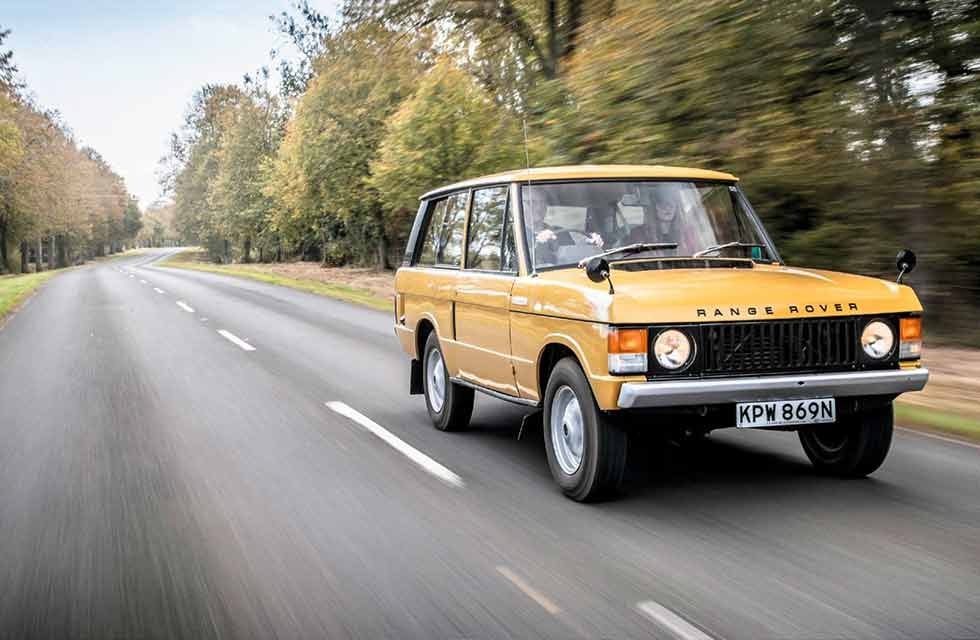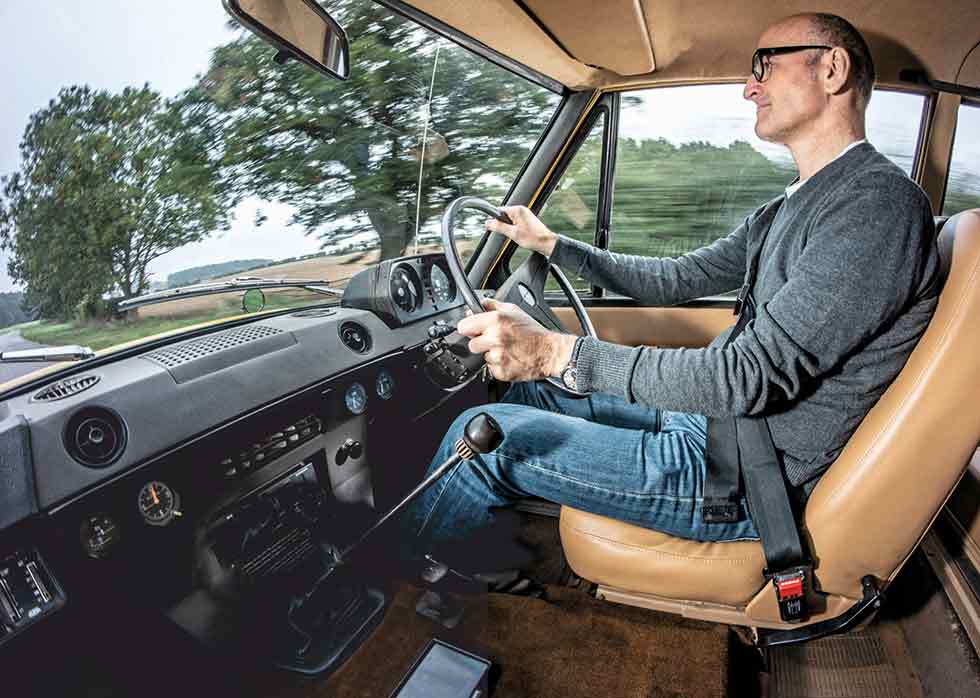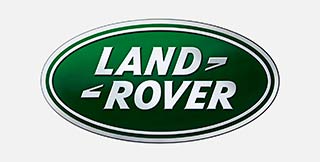
The List. Your dream drive made real Simon Stevenson prefers performance cars and modern classics, but he’s always wanted to try an early Range Rover. Will an immaculate 1973 Suffix C enchant him? Words Emma Woodcock. Photography Charlie Magee.
‘It’s so solid that you could jump on it’
The List – We put a reader in his dream early Range Rover for a day
One lucky reader goes off the beaten track in the original SUV.
Four rows wide and countless columns deep, hard-edged silhouettes stretch off into the darkness. Each one shares the same two-box shape – slatted grille meets bluff bonnet meets tall, square glasshouse. Simple yet utterly iconic, they could only be classic Range Rovers. Deep within their number I find Classic Cars reader Simon Stevenson. ‘This is stunning,’ he smiles. ‘I know it’s a cliché but it really is like an Aladdin’s Cave.’

The collection in question is owned by Rob Marsden, a Range Rover restorer who runs the aptly named Classic Range Rover firm. A one-time record shop owner, ex-Ibiza DJ and possibly the only person with a full skate bowl in his house, Rob is a man of varied passions, but the first generation Range Rover is his strongest love. He began his working life as an apprentice at a British marque dealer, throwing spanners under the luxury 4×4 every day of the week, and for the past 15 years he’s been doing the same on his own terms. Right now, he’s applying the finishing touches to a 1973 Suffix C in Bahama Gold. It’s Simon’s dream drive.
‘The way it clunks into gear is actually very satisfying. You can feel engagement through the pedals too’
Despite a driving history focused on smaller, sportier cars, Simon has had an interest in the first-generation Range Rover since childhood. ‘The first time I saw one was about 1974 at the Earls Court Motor Show and I remember seeing the stand they had it on, which had the car placed up on this outcrop of rocks. I was amazed by how big it was and came home with a bag full of brochures, most of them for the Range Rover.’

Simon’s next interaction with Land Rover’s proto-SUV came seven years later, but was every bit as important in embossing the Range Rover Classic in his memory. ‘My mate’s parents ran a pub down Sussex way,’ he remembers. ‘I must have been about 14 or 15. His stepdad had a Range Rover that was either the same colour or close to the car we’re driving today, and he let us have a go in it around a local field. It was the first time I’d ever driven any car and, though I never got it out of second gear, I remember how bouncy it was and how the car just soaked up the surface. That sticks in my mind – and so does the huge gearlever!’
‘It’s got a lazy sound to it, almost like it’s missing. You can almost hear every detonation, it’s like a Harley-Davidson’
As we chat, the Range Rover erupts into life, the 3.5-litre Rover V8 loping a long-short-long thunder down the single exhaust. ‘That’s exactly how I remember them sounding,’ Simon beams. ‘It’s got a lazy sound to it, almost like it’s misfiring. You can almost hear every detonation, it’s like a Harley-Davidson or something, and it’s a great sound. When I was a kid, you always knew when a Range Rover was coming up the road and it still sounds like nothing else. It’s even different from a Rover P5B, an SD1 and the other Leyland cars with the same basic engine.’
‘The difference with the Range Rover is that it invented its own niche, and it’s kind of contrary to my other tastes in cars – I generally go for low-slung sports cars or big-engined four-door saloons,’ Simon continues. ‘This is the one car on my list which is kind of out there; nobody had built anything like this before. To think it eventually became a luxury vehicle is crazy. [Designer] Spen King wouldn’t have believed you if you’d told him!’
Drawing closer, Simon is led round the car by each crisp and unadorned detail of the bodywork. A recently-imported Australian survivor which has seen nothing more than a full respray, this Suffix C is an especially impressive example of the breed. ‘The condition is immaculate, but it’s completely original – and under the bonnet it’s not like a show car. The colour is amazing too – I love that – and it’s little things like the simple front bumper and the exposed fuel cap that make the car. This is how it was designed; this is how it was meant to be.’
The door handle clicks under his fingers and Simon leans into the interior. Finished in the warm Caramac tones of Palomino PVC, complete with fitted floor mats, it’s an exercise in hose-down simplicity that would be lost on any modern Range Rover owner. Simon loves it. ‘That’s the smell of Seventies British Leyland!
Smell is hugely important to classic cars, it’s part of the experience. I love the fact that it hasn’t got a rev counter – it’s not about that – but the interior has that typical British Leyland functionality. As someone who drives more modern, power-assisted cars, the thin rimmed steering wheel really stands out as well.’
With the sun beginning to burn through the clouds, it’s time to leave for the prettier backdrops of the North Norfolk Wash. Together, we climb up into the sparse cabin and Simon contorts under the wheel as he searches for a comfortable driving position. ‘You don’t see steering wheels like this any more, but it’s totally in keeping with the rest of the car. I guess it gives it away that there’s no power-assisted steering and you’re going to have to work harder through the corners!
‘It’s really spacious, light and airy in here – the visibility is the first thing that’s struck me. I love the way the seat is integral with the seatbelt system too; they’ reweird belts but it feels like a fighter jet ejector seat. It’s a brilliant design.’ A firm ca-clunk signals that the chair has finally shifted on its runners. Simon’s legs drop to a less severe angle, his arms relax and we’re ready to drive.
Kings Lynn melts into meadows and it’s clear that driving the Range Rover takes some re-education for Simon. His steering inputs are quick and jumpy, fighting the car as it meanders around the road, while each gearshift combines trial-and-error with blind luck. ‘The length of the throw is enormous and there’s a lack of guidance into the notches. Finding where the gears are in the gate is a struggle; the centre is a no-man’s land and that’s quite disconcerting. Getting it into gear is an achievement! The chassis is wandering when it’s not under load too. Once you reach a corner it firms up and I actually feel more comfortable when I’m having to put effort into it, at least you’ve got resistance then. On the straights there’s none and it wants to follow every line in the road.’
A quiet field gives us the chance to take a quick break and explore Simon’s love of the Range Rover a little further. ‘There’s nothing on this car that wasn’t designed for a purpose,’ he expounds. ‘It’s a functional vehicle and that’s part of the joy. I like the idea of cars built for a reason. Take the iconic Ascot race-day folding tailgate. It’s a brilliant design; it’s so solid that you could jump on it and be fine. That’s the story of the Range Rover really – it’s function over form, yet it ends up being one of the most attractive cars ever made. It’s so uncontrived.’
Back on the road, every new mile sees the car grow smoother in response to Simon’s growing confidence. He hauls hard at the steering around tighter junctions until the road straightens into the Peddars Way. Largely straight but far from flat, it’s a characteristic Roman road that intersects acre after acre of unspoiled farmland. ‘The components are getting warmer now and driving the car is becoming second nature. My growing familiarity is helping too. It’s getting easier to find the edges of the Range Rover – the castellated corners of the bonnet really help you see right to the corners. Presumably they were designed for that!
‘The gear selection is becoming more straightforward as the car warms through; downshifts especially. It’s getting better by the mile. Finding their location and dealing with the loose gate is all down to experience though. I’m less scared to shovel the shifter now – it needs a firm, determined hand and the way it clunks into gear is actually very satisfying. You can feel engagement through the pedals too. I like that I can rest my foot on the clutch and feel the transmission. It’s like I’m in touch with it. The brakes are fine too and the accelerator is very direct, it’s clearly not a drive-by-wire and it isn’t adulterated at all.’
We turn on to a narrower road that bucks and twists around the scenery. Dappled by watercolour light, it looks idyllic and Simon takes the opportunity to explore more of the engine’s range. ‘There’s no lag at all! It’s beautifully tractable, is that the word? Elastic, definitely. It’s lovely, there’s good delivery through the rev range, not that I know what revs we’re actually pulling! The acceleration through third gear is really quite decent.’ To prove his point, he pushes the throttle to the floor and the bent-eight bellows in response.We both smile. It’s easy to see the appeal.
A gravel track appears along the treeline and we can’t resist.
Simon cracks a huge smile as he points three feet of Bahama Gold bonnet at the rough stuff. ‘It’s only a tiny bit of off-roading, but you really get a feel for what it could do on a more difficult track. There are no suspension jolts and you can really feel the axle articulation in action. See the big pothole on this hill? The Range Rover can drive right through and it just doesn’t care.’ Returning to the tarmac, he’s equally effusive about the car’s ride quality on the public road. ‘The seats and suspension stand out over any road surface, they’re very compliant. It rides so beautifully you don’t even think about it. The whole driving experience is far more relaxed than a modern car. There’s no need to drive faster or push it hard round corners, but that’s part of the beauty of it.’
Simon has built a comfortable rhythm with the car now, settling to a 45mph cruise as we sway back towards civilisation and the stately lawns of the Sandringham Estate. The Range Rover is in natural territory here – Queen Elizabeth II and the royal family have used the model regularly since 1974, adding to the Rangie’s aura of dignified Britishness.
We daren’t stay long, and Simon dives deeper into the rev range as we gather pace along the B1440. ‘It’s got a beautiful warble… everyone uses the word “warble” to describe a V8 noise like this, but it really does. It’s a great sound! The transmission whine does become intrusive at these speeds though; I’d need a fifth gear to drive it much faster or take it on a motorway.’ Tree-lined, wide and flowing, the B1440 complements the Range Rover’s strengths and our speed grows further still. ‘In some ways, you can feel the play in the car dial out above 45mph. Between there and 55mph, the Range Rover feels firmer and a lot more comfortable with itself.’
Only too soon, we’re back on the major roads to Rob’s workshop and Simon is in a contemplative mood. ‘It’s brought back some amazing memories,’ he smiles. ‘If I were to own one, I’d want a very early car like this one, but I’d also want to drive it everywhere, every day and I just don’t think you could really do that. I love the rawness of the experience and I can see why you’d have one as a part of a fleet of, say, ten cars, but for me it’s scratched an itch. I’m really glad I’ve driven it.’
Thanks to Rob Marsden of Classic Range Rover and the car’s owner Gary Wilton
TECHNICAL DATA FILE SPECIFICATIONS 1973 Range Rover Suffix C
Engine 3528cc V8, OHV, twin Zenith-Stromberg 175CD carbs
Max Power 130bhp @ 5000rpm
Max Torque 185lb ft @ 2500rpm
Transmission Four-speed manual with transfer box and lockable centre diff, four-wheel drive
Steering Burman recirculating ball
Suspension Front: live axle, radius arms, coil springs, telescopic dampers, Panhard rod; Rear: live axle trailing links A-frame, coil springs, telescopic dampers, self-levelling unit
Brakes Servo-assisted discs all round
Weight 1770kg
Performance Top speed: 96mph; 0-60mph: 15.5sec;
Fuel consumption 14mpg
Cost new £2400
Classic Cars Price Guide £14,000-£37,500
Functional styling was mostly the work of Rover engineers. Range Rovers with a letter suffix in the chassis number are the most collectible Engine bay reveals this example has been working for its living. Ultra-soft springing pays off as soon as you leave the road. Long throw and wide gate of the gearshift require quite a bit of acclimatization. Simon savours the hose-clean interior and prepares to work hard at that thin-rimmed wheel.
SIMON’S DREAM DRIVE LIST
Lancia Stratos
‘This is a single-minded vision – a purpose-built rally car with a thoroughbred engine.’
Fiat Dino Coupé
‘The mafia boss in The Italian Job had one; it’s the real star of the film.’
Ford Cortina-Lotus
‘So much cooler than the MkI; an under-appreciated beauty.’
BMW M635CSI E24
‘To discover the difference between it and the regular 635 I used to own.’
Maserati Shamal
‘I love the brutalist styling, bespoke power units and exclusivity of it.’
Ford Capri 3000
‘Matt. Black. Bonnet. I had a Corgi Roger Clark one as a kid – is the real one as much fun?’
Fiat 130 Coupe
‘A proper Seventies luxury car; so opulent and slightly seedy. Heaven knows who it was designed for!’
Mercedes-Benz 500E W124
‘To the uninitiated it’s just another Merc saloon, but there’s that huge power unit for those in the know!’
Lancia Beta Montecarlo
‘An everyman exotic; I love the looks.’
Range Rover
‘First car I ever drove, at 14. I’d love to get out of first gear this time!’
SIMON’S MOTORING CV
A man for modern classics with a sporty bent
MINI 1275GT
‘My first interesting car and I loved the way it looked, in black with a gold side-stripe. It broke down all the time, but I did love it, though…’
PEUGEOT 309GTI
‘The 205’s ugly sister! A lovely torquey engine and incredible handling. It felt like a properly-built car, too. I kept it for a couple of years.’
FIAT CINQUECENTO SPORTING
‘Hilarious fun! A tiny buzzbox, brilliant for nipping around town – and it felt a lot faster than it was. I owned it for four years.’
BMW 635CSI E24
‘I finally bought myself one in 2013. It was everything I’d hoped, but when they started to go up in value I didn’t want to drive it so much…’
ALFA ROMEO GTV V6
‘I was seduced by the Busso engine and bought the car very cheaply in 2015. It’s still in my garage, with a quick and reliable Saab 9-5 Aero.’






